Hamo Thornycroft
| Hamo Thornycroft | |
|---|---|
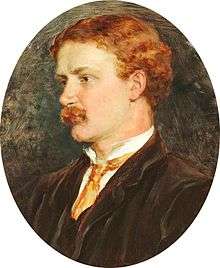 William Hamo Thornycroft, 1884 by Theodore Blake Wirgman | |
| Born |
9 March 1850 London, England |
| Died | 18 December 1925 (aged 75) |
| Occupation | Artist |
| Known for | Sculpture |

Sir William Hamo Thornycroft RA (9 March 1850 – 18 December 1925) was an English sculptor, responsible for some of London’s best known statues. He was a keen student of classical sculpture and became one of the youngest members of the Royal Academy.
He was the leading figure in the movement known as the New Sculpture, which provided a transition between the neoclassical styles of the 19th century and its later fin-de-siècle and modernist departures.
Biography
Hamo Thornycroft belonged to the Thornycroft family of sculptors. His father, Thomas, mother Mary, and grandfather John Francis were all distinguished sculptors. He was born in London. His brother, John Isaac Thornycroft, became a successful naval engineer; their sister, Theresa, was the mother of the poet Siegfried Sassoon; Theresa and sisters Alyce and Helen Thornycroft were artists. Hamo's early training was with his parents and he developed a passionate and precocious attachment to Classical sculpture. He subsequently studied at the Royal Academy of Arts, where his primary influence was the painter-sculptor Frederic Leighton. Hamo won the Gold Medal of the Royal Academy in 1876, with the statue Warrior Bearing a Wounded Youth.
He was the leading figure in the movement known as the New Sculpture.[1] His close personal friend, the critic Edmund Gosse, coined the term "The New Sculpture" in 1894 and formulated its early principles from his relationship with Thornycroft. Thornycroft created a series of statues in the ideal genre in the late 1870s and early 1880s that sought to reanimate the format of the classical statue. These included Lot's Wife (1878), Artemis and her Hound (1880 plaster, 1882 marble), the Homeric bowman Teucer (1881 plaster, 1882 bronze), and the Mower (1884 plaster, 1894 bronze), arguably the first life-size freestanding statue of a contemporary laborer in 19th-century sculpture.
Thornycroft was one of the youngest artists to be elected to the Royal Academy, in 1882, the same year the bronze cast of Teucer was purchased for the British nation under the auspices of the Chantrey Bequest. After 1884, Thornycroft's reputation was secure and he received commissions for a number of major monuments, most notably the innovative General Gordon. Thornycroft continued to be a central member of the sculptural establishment and the Royal Academy into the 20th century. He was knighted in 1917. He became increasingly resistant to new developments in sculpture, although his work of the early 1880s helped to catalyze sculpture in the United Kingdom towards those new directions. In sum, he provided an important transition between the neoclassical and academic styles of the 19th century and its fin-de-siècle and modernist departures.
A blue plaque commemorates Thornycroft at 2b Melbury Road, Kensington,[2] his studio designed by lifelong friend John Belcher, c.1892.[3][4]
Bibliography
- Beattie, Susan. The New Sculpture. New Haven: Yale University Press, 1983.
- Friedman, Terry, ed. The Alliance of Sculpture and Architecture. Leeds: Henry Moore Institute, 1993.
- Getsy, David. Body Doubles: Sculpture in Britain, 1877–1905. New Haven and London: Yale University Press, 2004.
- Gosse, Edmund. "Our Living Artists: Hamo Thornycroft, A.R.A." Magazine of Art, 1881, pp. 328–32.
- Manning, Elfrida. Marble and Bronze: The Art and Life of Hamo Thornycroft. London: Trefoil Books, 1982.
- Read, Benedict. Victorian Sculpture. New Haven: Yale University Press, 1982.
- White, Adam. Hamo Thornycroft and the Martyr General. Leeds: Henry Moore Institute, 1991.
Writings
- "Lecture to the Sculpture Students of the Royal Academy of Art, 1885" reprinted in the Journal of the Walpole Society, vol. 69 (2007): 211-26.
Public statues
- Alfred the Great - Winchester
- William Ewart Gladstone in robes of Lord Rector of Glasgow University - Glasgow
- Oliver Cromwell - outside the Palace of Westminster
- General Gordon - Victoria Embankment
- John Bright - Rochdale
- Sir Daniel Dixon - Belfast City Hall
- William Lord Armstrong - Newcastle-on-Tyne
- Cecil Rhodes - Kimberley, South Africa[5]
- A Sower - Kew Gardens
- Stepping Stones, Kibble Palace, Glasgow Botanic Gardens
Gallery
- Lot's Wife by Hamo Thornycroft, Victoria & Albert Museum, 1878.[6] Previously located in Leighton House.[7]
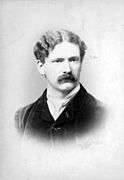
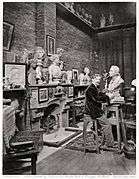 Thornycroft in his studio, 1883[9]
Thornycroft in his studio, 1883[9]- A Sower, in Kew Gardens, 1886[10]
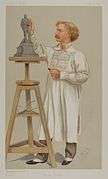



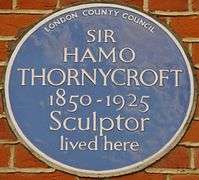 Blue plaque, 2a Melbury Road, London
Blue plaque, 2a Melbury Road, London
Architectural
- Friezes for the Institute of Chartered Accountants building by John Belcher.
References
- ↑ "Thornycroft, William Hamo". Who's Who. Vol. 59. 1907. p. 1747.
- ↑ "THORNYCROFT, SIR HAMO (1850-1925)". English Heritage. Retrieved 2012-07-01.
- ↑ Baistow (1892). "Sir Hamo Thornycroft's studio, 2a Melbury Road, Holland Park, London". RIBApix. Architectural Press Archive / RIBA Collections. Retrieved 12 September 2016.
- ↑ "The Holland estate: Since 1874, in Survey of London: Volume 37, Northern Kensington,". British History Online. F H W Sheppard (London). 1973. pp. 126–150. Retrieved 15 September 2016.
- ↑ The Solomon, Kimberley. Accessed 28 February 2016
- ↑ Spielmann, M. H. (1911). "1911 Encyclopædia Britannica/Thornycroft, William Hamo". Wikisource. Retrieved 15 September 2016.
- ↑ "Statue of Lot's Wife". The Courthauld Gallery. Conway Library, Courtauld Institute of Art: The Courtauld Institute of Art, London. Retrieved 15 September 2016.
Location England, London, Leighton House
- ↑ "Hamo Thornycroft". National Portrait Gallery. National Portrait Gallery, London. 2016. Retrieved 15 September 2016.
albumen cabinet card, 1880s
- ↑ "Hamo Thornycroft". National Portrait Gallery. National Portrait Gallery, London. 2016. Retrieved 15 September 2016.
photogravure, 1883, published 1884
- ↑ Marsh, Dr. Jan (2016). "Later Victorian Portraits Catalogue". National Portrait Gallery. National Portrait Gallery, London. Retrieved 15 September 2016.
- ↑ "Sir (William) Hamo Thornycroft ('Men of the Day. No. 533.')". National Portrait Gallery. National Portrait Gallery, London. 2016. Retrieved 15 September 2016.
published in Vanity Fair 20 February 1892
- ↑ "Alfred the Great (849-899)". The Victorian Web. 20 August 2009. Retrieved 15 September 2016.
- ↑ "Alfred, Lord Tennyson". TrinityCollegeChapel. Trinity College Cambridge. Retrieved 15 September 2016.
Hamo Thornycroft, R.A., carved this in 1909.
External links
| Wikimedia Commons has media related to Hamo Thornycroft. |
| Wikisource has the text of a 1911 Encyclopædia Britannica article about Hamo Thornycroft. |
- Thornycroft works in the Tate Collection, London
- The Mower in the Walker Art Gallery, Liverpool
- Biography on Bob Speel's Site
- The Victorian Web, featuring links to images of works
- "Archival material relating to Hamo Thornycroft". UK National Archives.
- Portraits of Hamo Thornycroft at the National Portrait Gallery, London
